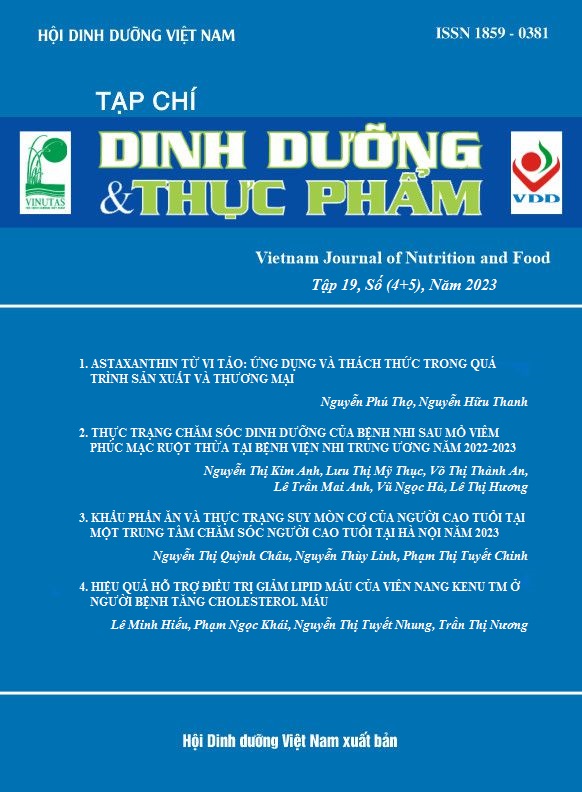VALIDATION METHOD FOR DETERMINATION OF 5,6-DEHYDROKAVAIN IN FRESH LEAVES AND LEAF POWDER OF ALPINIA ZERUMBET BY HIGH PERFORMANCE LIQUID CHROMATOGRAPHY
Main Article Content
Abstract
Aims: To validate a method to detect 5,6-dehydrokavain concentration in fresh leaves and leaf powder of Alpinia zerumbet by high performance liquid chromatography with a photodiode array detector.
Methods: 5,6-dehydrokavain was extracted by sonication in methanol at 40 oC, then separated by a reversed phase C8 column using a mobile phase including methanol and 1% aqueous acetic acid. The analysis time is 10 minutes and the PDA detector was performed at 343 nm. Validation parameters were performed according to the guidelines of AOAC 2016.
Results: The validated method proved to be linear in the range of 0.05 to 10 μg/ml (correlation coefficient: r = 1). The limit of detection in fresh leaves and leaf powder of Alpinia zerumbet were -30.3 µg/100g and 60.6 µg/100g, respectively. The limit of quantification in fresh leaves and leaf powder of Alpinia zerumbet were 100 µg/100g and 200 µg/100g, respectively. The accuracy was within the range from 99,7 to 104.4 %, with the relative standard deviation (RSD%) of 1.0 – 6.6 %.
Conclusion: The validated parameters have met the requirement of Association of Official Agricultural Chemists (AOAC). This reliable method would be useful for the study and determination of 5,6-dehydrokavain in fresh leaves and leaf powder of Alpinia zerumbet.
Keywords
5,6-dehydrokavain, shell ginger, 𝘈𝘭𝘱𝘪𝘯𝘪𝘢 𝘻𝘦𝘻𝘶𝘮𝘣𝘦𝘵, high performance liquid chromatography
Article Details
References
2. Pham Thi Be Tu and Shinkichi Tawata. Anti-Obesity Effects of Hispidin and Alpinia zerumbet Bioactives in 3T3-L1 Adipocytes. Molecules. 2014;19:16656-16671. Doi:10.3390/molecules191016656.
3. Yen Thi Kim Nguyen, Jeong Yong Moon, Jiyeon Ryu, Sangmi Eum, Tran The Bach and Somi Kim Cho. Methanol Extract of Aerial Parts of Pavetta indica L. Enhances the Cytotoxic Effect of Doxorubicin and Induces Radiation Sensitization in MDA‐MB 231Triple‐Negative Breast Cancer Cells. Molecules. 2019;24:2273. Doi:10.3390/molecules24122273.
4. Rao YK, Shih HN, Lee YC, Cheng WT, Hung HC, Wang HC, Chen CJ, Tzeng YM, Lee, MJ. Purification of kavalactones from Alpinia zerumbet and their protective actions against hydrogen peroxide-induced cytotoxicity in PC12 cells. J Biosci Bioeng. 2014;118:679–688.
5. Fuad Ali Tarbah. Analytical studies on the kavain metabolism in human specimen and liver cell lines. Dissertation zur forensischen Toxikologie - PhD Thesis in Forensic Toxicology. T + K 71. 2004;(2):89. Https://d-nb.info/970019947/34.
6. Viorica Lopez-Avila and George Yefchak. Identification of Compounds in Commercial Kava Extracts by Gas Chromatography with Electron Ionization High-Resolution Mass Spectrometry. The Open Analytical Chemistry Journal. 2009;3:22-31.
7. Cristiane P. Victório, Daniela S. Alviano, Celuta S. Alviano, Celso L. S. Lage. Chemical composition of the fractions of leaf oil of Alpinia zerumbet (Pers.) B.L. Burtt & R.M. Sm. and antimicrobial activity. Rev brasfarmacogn. 2009;19(3). Doi: 10.1590/S0102-695X2009000500008.
8. Lahlou S, Galindo CA, Leal-Cardoso JH, Fonteles MC, Duarte GP. Cardiovascular effects of the essential oil of Alpinia zerumbet leaves and its main constituent, Terpinen-4-ol, in rats: role of the autonomic nervous system. Planta Med. 2002;68(12):1097-1102. Doi: 10.1055/s-2002-36336.
9. Makise T, et al. Analyses of expression of “Sirt 1” gene of mouse by Jipang Ginger (fermented Alpinia Zerumbet. Transgenic INC. 2014.
10. Upadhyay A, Makise T. Change in gene expression by Alpinia leaf extract”. University of the Ryukyus. 2012.
11. AOAC Official methods of Analysis (2016), Appendix F. Guideline for standard method performance requirements.
Similar Articles
- Phu Tho NGUYEN, Thạc sĩ Thi To Uyen NGUYEN, TS Huu Thanh NGUYEN, Thạc sĩ Chi Thien DANG, Thi Phuong Thao NGUYEN, ASSESSMENT OF CHANGES IN BIOACTIVE ACTIVES CONTENT AND ANTIOXIDANT ACTIVITY OF YOUNG RICE LEAF (Oryza sativa) POWDER DURING PROCESSING , Vietnam Journal of Nutrition & Food: Vol. 18 No. 5+6 (2022)
You may also start an advanced similarity search for this article.


